2023
Western States Rural Transportation Technology Implementers Forum
June 13th-15th, Yreka, California

SCHEDULE OF EVENTS
Tuesday, June 13, 2023
4:00 pm to 7:00 pm Registration
5:00 pm to 6:30 pm Reception (no-host)
6:30 pm to 9:00 pm Dinner
Wednesday, June 14, 2023
7:00 am to 8:00 am Breakfast
8:00 am to 12:05 pm Welcome and Technical Presentations
12:05 pm to 1:00 pm Lunch
1:00 pm to 5:00 pm Technical Presentations, Evaluations, Remarks
6:00 pm to 11:00 pm Dinner and Networking Session
Thursday, June 15, 2023
7:00 am to 8:00 am Breakfast
8:00 am to 12:00 pm Technical Presentations
12:00 pm to 12:20 pm Speaker and Attendee Recognition
12:00 pm to 12:20 pm Concluding Remarks and Evaluations
12:20 pm to End Lunch
PRESENTATIONS AND DEMONSTRATIONS*
Jeremiah Pearce
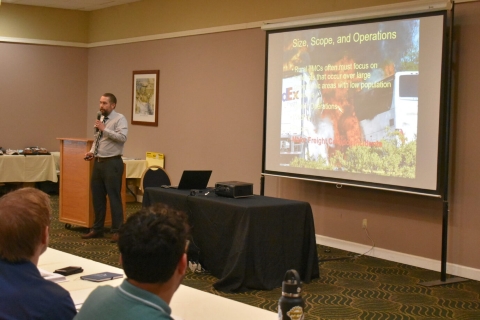
Photo by Doug Galarus
Keith Koeppen
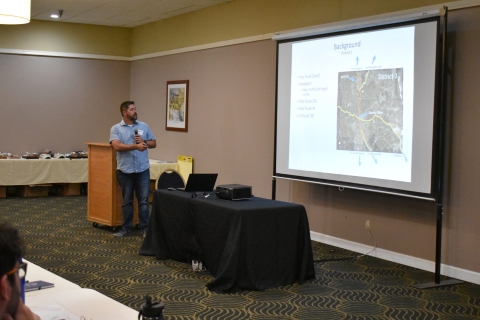
Photo by Doug Galarus
Kenneth Shipley
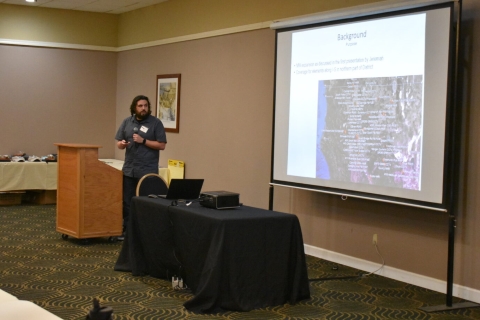
Photo by Doug Galarus
Playbook CMS Messaging via ActiveITS Databus
Andres Chavez, Jared Sun
Caltrans District 3
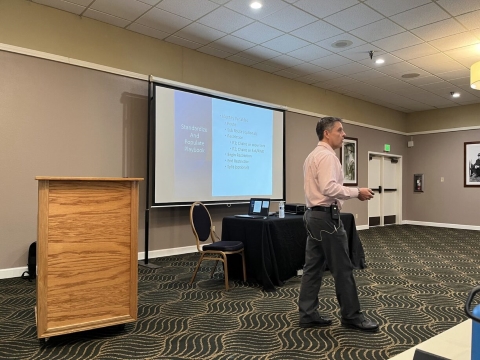
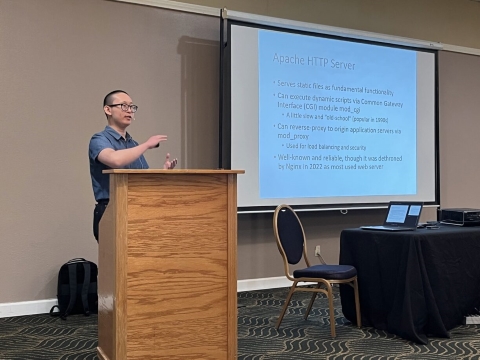
|
Incidents such as fires, floods, or storms dictate quick TMC response to alert the public of the road conditions. To streamline and simplify the alerting process, Caltrans District 3 designed and built a system that takes operators just a few selections and clicks to immediately send out road condition updates. Transportation Electrical Engineers Andres Chavez and Jared Sun discussed how they architected a web application and server to interface with the existing ATMS API and database to send batches of preset sign messages from a message playbook. They explained how the system handled increasingly complex scenarios such as simultaneous chain controls and road closures. The duo demonstrated how their system connected to external systems to send automated E-Pages and log updates to their TMC Activity Logger. Andres and Jared shared lessons learned and how other agencies can create similar applications to connect their traffic management systems with external systems and streamline operations.
|
Andres Chavez

Photo by Leann Koon
Jared Sun

Photo by Leann Koon
Caltrans Satellite Communications
Eric Ho, Bud Rojas, Ernesto Fermin*
Caltrans Office of Radio Communications
*Speaker
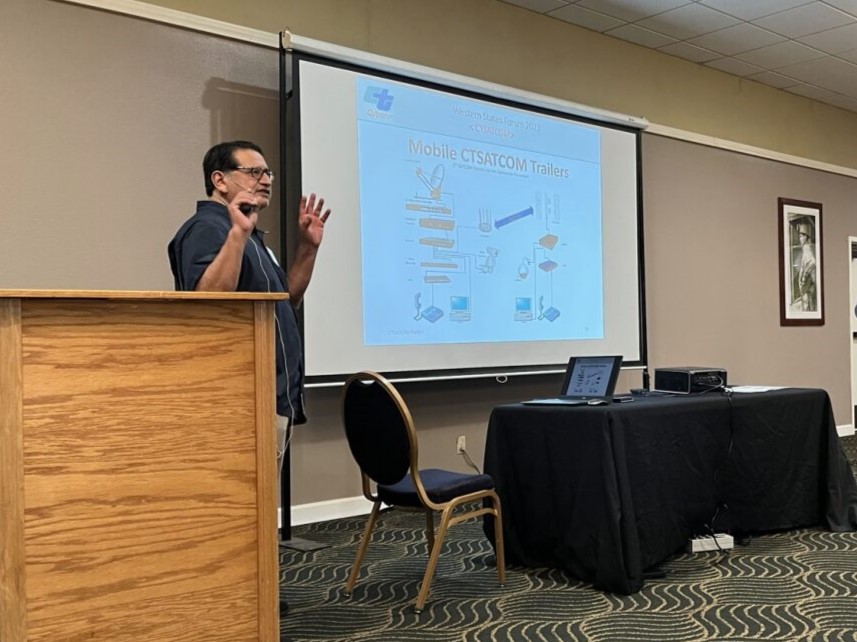
|
The Caltrans Satellite Communications group from the Office of Radio Communications brought over their mobile communications truck and trailer from District 1 and conducted a live demonstration in the parking lot. Ernesto Fermin started the presentation / demonstration with an overview of general satellite communications, the program need, and a look at several fixed communications sites in California. He then reviewed in depth the trailer design, deployment, and operations, concluding with a review of lessons learned and how they are looking towards the future. Ernesto also described and showed their compact rapid deployable unit, which is an advanced self-contained mobile communications solution. After addressing several questions, the audience went outside to walk through the trailer and get a close look at its systems and capabilities. Caltrans District 1 staff provided details during the presentation and guided participants through the trailer.
|
Ernesto Fermin

Photo by Leann Koon
UDOT Weather Operations’ Wildfire and Debris Flow Response
Jeff Williams, Cody Oppermann
Utah Department of Transportation
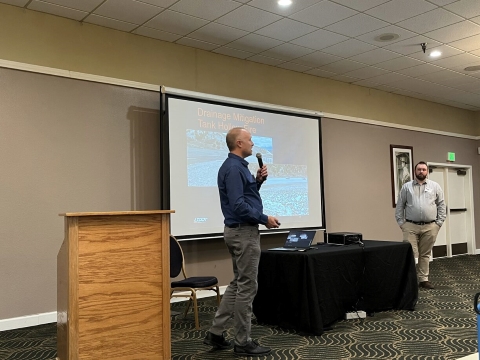
|
The UDOT Weather Operations group brought a unique perspective to the Forum agenda this year with their presentation about wildfire and debris flow response. While public information and traffic control are important during a wildfire, it is after the fire when rainfall causes debris flows that affect roads near burn scars that is of great concern to UDOT. Jeff Williams and Cody Oppermann introduced the project effort and need by reviewing a fire and its aftermath and how the system was implemented. They then described how the Weather Operations group evaluates multiple factors about a burn scar and collaborates with several different organizations to analyze burn severity and debris flow probability. They also explained how the groups collaborate to deploy portable Road Weather Information Systems – Environmental Sensing Stations (ESS) and the process and setup of these portable ESS.
|
Jeff Williams (left) and Cody Oppermann (right)

Photo by Leann Koon
Managed Lighting Control Systems
Eric MacGill, Kevin Maxwell
Nevada Department of Transportation
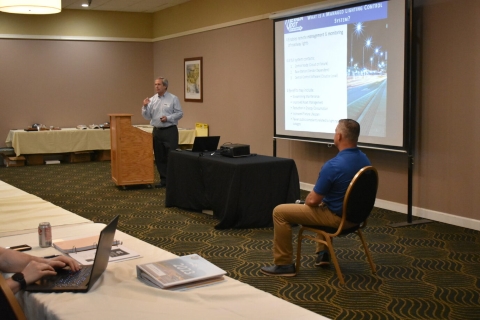
|
Nevada DOT Engineers Eric MacGill and Kevin Maxwell presented their project work on a managed lighting control system. They first reviewed the basic components of a generic system, project goals, and the development of a managed lighting handbook. They described the rural and urban pilot project sites and how the rapidly changing and evolving technology impacted the project. Eric and Kevin concluded with a live exercise on calculating and designing for required minimum lighting levels, along with some discussion on lessons learned thus far.
|
Eric MacGill (left) and Kevin Maxwell (right)

Photo by Doug Galarus
NDOT 3 GIS Telecommunications Infrastructure Management Software
Kerry Palmer
Nevada Department of Transportation
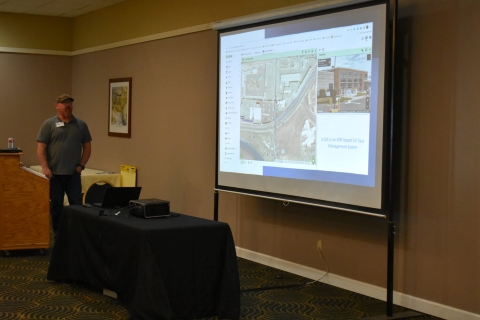
|
Nevada DOT System Engineer Kerry Palmer reviewed the 3 GIS ESRI-based telecommunications infrastructure management tool that NDOT has adapted for effectively managing its telecommunications infrastructure. He first gave a general introduction to GIS and how data is collected in the mobile application. He then delved into how the solution manages the data and integrates it into the various map layers. Kerry discussed conduit and duct management using the 3 GIS solution as well as right of way and easements. Topics included how inspections are handled as well as how the mobile application can receive updated information in real-time in the field, including design changes, splicing changes, or work orders. He explained the file management features along with public facing content and public information requests.
|
Kerry Palmer

Photo by Doug Galarus
C-Street Wrong Way Detection System
Scott Mercer
Washington State Department of Transportation
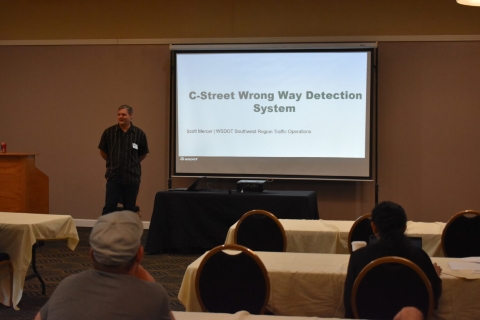
|
The Southwest Region of Washington State DOT worked for several years to identify and deploy a wrong-way vehicle detection system that accurately detects wrong way vehicles in a challenging location, while working within a limited budget. Scott Mercer, the SW Region’s ITS Network Manager, described the site and the problems identified. He went through each of the systems tested, including equipment, software, and process, and lessons learned as the site solution evolved.
|
Scott Mercer

Photo by Doug Galarus
TOP
*These presentations are posted as developed by the speakers and presented at the 2023 Forum. Alternative accessible formats of these documents can be provided upon request. Persons with disabilities who need an alternative accessible format of this information, or who require some other reasonable accommodation to participate, should contact Neil Hetherington, Visual Communications Manager, Western Transportation Institute, Montana State University, PO Box 174250, Bozeman, MT 59717-4250, telephone number 406-994-3566, e-mail: hetherington "at" montana.edu; or Dana May, Business Development Manager, Western Transportation Institute, Montana State University, PO Box 174250, Bozeman, MT 59717-4250, telephone number (406) 994-6361, e-mail: dana.may "at" montana.edu. |












